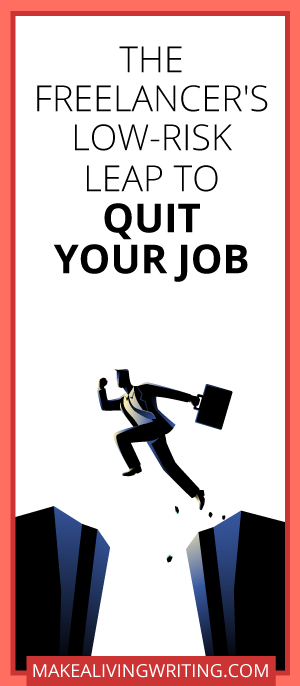
If you’ve got nerves of steel, piles of money in the bank, or you’re living rent free in your sister’s basement, go for it.
Or if you stare in the mirror every day and recite this old-school pro wrestler’s mantra: “I dine on danger and snack on death,” maybe you’ve got the guts to quit your job and walk out.
That wasn’t me. I’ve got plenty of hustle and freelanced on the side for years.
But making the leap from a job as a staff writer to full-time freelancing felt a little too risky. As in three kids, a mortgage, pending divorce, life…
Sound familiar?
If you’re a risk-averse freelancer, you need to find a practical way to quit your job for full-time freelancing with the least financial impact as possible.
When I finally walked away from my day job last year, I already had $4,000 in monthly freelance contracts lined up, and I’ve made more than that every month since.
Want to know how I did it? Here’s my low-risk leap strategy to full-time freelancing:
Be patient
Maybe you don’t love your day job, but it pays the bills. Stick around until you get your freelance life figured out.
It’s a much better way to make your exit than quitting without a plan in place, especially a plan to replace your income.
But don’t just sit around waiting for something magical to happen. Here are some things you can do:
Figure out how much you need to make
Crunch your numbers for stuff like your mortgage/rent, food, utilities, car, debt, savings, health insurance, spending money. Get real about how much you need to make to pay your bills.
When you set a monthly income target for freelancing, you’re a lot more likely to swear off low-paid content mill work for better paying clients.
Set a date
When will you make the leap to full-time freelancing? Be realistic. For the risk averse, you want to avoid living on bare bones rations after you quit your job.
When you set a date and commit, you’ll start thinking about your day job and freelance work differently. It’s the kind of mindset shift you need to make to be successful.
Note: I was pretty comfortable with my day job as a writer and a solid part-time freelance business. And then something happened. My employer announced plans to relocate in six months, turning my 20-minute commute into an hour-plus.
That’s when I decided I wouldn’t be joining my co-workers when the company made the move.
Map out an exit plan
You don’t have to have all the answers right away. Give yourself some time to think about how you’re going to quit your job and answer questions like:
- What’s your exit date? Write it down. Commit.
- When will you tell your employer? Set a date, and think about how to break the news. (This could be a opportunity to turn your day job into a client.)
- What are you going to do about health insurance? Maybe you’re covered on your partner’s plan or you’ll purchase private insurance.
- How are you going to find clients to replace your day-job income? Ramp up your marketing efforts. Ask your network for referrals. Map out an aggressive marketing plan if you don’t already have one.
- How long will it take? If you’ve been tracking pitches and assignments, you should have some idea of what you can expect from your marketing efforts.
Want to quit your job for full-time freelancing? Set a date. Tell at least one person. And start planning to make it happen.
Pay off debt, save money
Here’s another low-risk strategy to help you quit your job for full-time freelancing. Pay off debt and save some money…first.
If that means you hang on to your day job for another six months or a year to pay off credit card debt, or a car loan, it’s worth it for the risk-averse. You’ll step into full-time freelancing with less stress and fewer financial obligations.
How much should you save? It depends on your comfort level. One to three months of expenses is a good place to start. But if you want even more peace of mind, save enough to cover six months of expenses like freelancer Emily Omier.
Note: I had about $10,000 saved from freelance work when I quit my day job and cashed out $5,000 in paid time off from my employer. And I had most of my debts paid off except for a mortgage and student loan.
Flex your marketing muscles
If you want to quit your job for full-time freelancing, flex your marketing muscles before you walk away. It’s a lot better to get a handle on this while you still have a steady income.
Why? At first, it can take some time to send out enough query letters and letters of introduction to start landing assignments. It’s where a lot of quit-your-job-without-a-plan freelancers go wrong, struggle, and too often give up.
But it doesn’t have to be that way. While you’re still enjoying the benefits of a day-job paycheck, make freelance marketing your part-time job. Here’s how:
Set a process goal
You can’t entirely control the amount of money you’ll make, but you can control your effort. So instead of measuring your effort in terms of income, use a process goal to measure effort. Here’s an example:
Send out 100 pitch letters a month. If you’ve been sending out zero, start with five a week. Move up to 10, and keep going.
You can measure a process goal like this, track pitches and assignments, and get an idea of what it’s going to take you to start earning the income you want from writing.
If you really want a stretch goal: The late Chris Marlow encouraged writers to send out 400 pitch letters a month, at least at first, as the path to becoming a fully-booked freelancer.
Note: Before I made the leap to full-time freelancing, I sent out an average of 150 letters of introduction to business in my niche (health and fitness) a month, usually on the 8 p.m. to midnight shift after I got my kids to bed. After a couple months, I had lots of warm leads and a handful of long-term contracts.
When can you fit in extra time for freelance marketing while you plan your exit?
Tap your day job
When my employer announced plans to move, I decided to make the leap to full-time freelancing instead of sitting behind the wheel-in rush-hour traffic every day.
If you quit your job for full-time freelancing, can you take your employer with you? Maybe.
- If you’re in a hostile work environment or job you absolutely hate, its probably not an option.
- If your day job doesn’t involve any writing, don’t rule it out. Reach out to the marketing director and ask about freelance opportunities.
If you’re on good terms with your employer, consider turning your day job into a freelance client. Here’s how I did it:
- Map out your role as a contractor. What writing projects and responsibilities could you take with you as a freelance contractor? Define your role. Think about why you want to leave your day job.
- Set your rates. How much will you charge your employer as a freelance contractor? Figure it out. Keep in mind, it should be considerably higher than your day-job hourly rate as Holly Hughes-Barnes explains.
- Talk it out with a friend. Find an experienced freelancer, writing coach, or business professional who works with contractors. Share your exit plan and proposal to turn your employer into a client. Talk out the pros and cons.
- Pitch the idea to your manager. It’s probably the scariest part of the process. What if your manager gives you the old Donald Trump line: “You’re fired?” If you’re on good terms with your employer, it’s unlikely. But it’s always a possibility. Just open the conversation by sharing your proposal, and see what happens. You might be surprised by the outcome.
Note: Even though I had a great track record with my employer as a health and marketing writer, I was still nervous about this. But it turned out to be an easy conversation. The CEO said: “We knew the move would probably displace some employees because of the commute, and you’re one of them. This sounds like a great option for you and for us.”
Can you turn your day job into a freelance client?
Find an anchor client
If you’re not going to be able to turn your day job into a client, find an anchor client before you quit. It’s the most risk-averse way to be a freelance writer vs. chasing one-off assignments all the time. These are clients that pay pro rates, pay on time, and always have plenty of work.
Looking for an anchor client? Carol Tice recommends:
- Companies with 50-100 or more employees
- National nonprofits with $10+ million budgets
- National magazines with large circulations
- Niche publications with a well-heeled readership
- Companies or magazines with a publishing schedule of articles, blog posts, website content, and marketing materials that can keep you busy for months
Note: When freelancing was only my part-time gig, I chased a lot of one-off writing jobs. But it’s tough to create consistent income that way. Today, I have seven anchor clients, and I’m on track to earn $72,000 in my first year of full-time freelancing.
Are you targeting anchor clients in your niche?
Full-time freelancing doesn’t have to be risky
If you do it right, you can make more money writing than a lot of day jobs, manage your own schedule, earn consistent income, and enjoy work you love. Now I wonder why I didn’t make the move sooner. Thanks for the nudge, Carol.
Ready to quit your day job for full-time freelancing? Leave a comment below, and let’s discuss.
Evan Jensen is the blog editor for Make a Living Writing. When he’s not on a writing deadline or catching up on emails, he’s training to run another 100-mile ultra-marathon.










